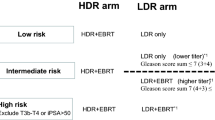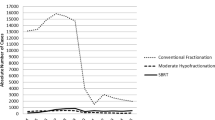Abstract
This article on low dose rate (LDR) prostate brachytherapy reviews long-term results, patient selection and quality of life issues. Mature results from the United States and United Kingdom are reported and issues regarding definitions of biochemical failure are discussed. Latest data comparing brachytherapy with radical prostatectomy or no definitive treatment and also the risk of secondary malignancies after prostate brachytherapy are presented. Urological parameters of patient selection and quality of life issues concerning urinary, sexual and bowel function are reviewed. The position of prostate brachytherapy next to surgery as a first-line treatment modality is demonstrated.
This is a preview of subscription content, access via your institution
Access options
Subscribe to this journal
Receive 4 print issues and online access
$259.00 per year
only $64.75 per issue
Buy this article
- Purchase on Springer Link
- Instant access to full article PDF
Prices may be subject to local taxes which are calculated during checkout


Similar content being viewed by others
References
Greenlee RT, Hill-Harmon MB, Murray T, Thun M . Cancer statistics, 2001. CA Cancer J Clin 2001; 51: 15–36.
The Office for National Statistics. Health Statistics Quarterly Autumn 2000.
The Office for National Statistics. Cancer Statistics registrations: Registrations of cancer diagnosed in 2004, England. ONS: London, 2007.
Kupelian PA, Potters L, Khuntia D, Ciezki JP, Reddy CA, Reuther AM et al. Radical prostatectomy, external beam radiotherapy <72 Gy, external beam radiotherapy > or =72 Gy, permanent seed implantation, or combined seeds/external beam radiotherapy for stage T1-T2 prostate cancer. Int J Radiat Oncol Biol Phys 2004; 58: 25–33.
Potters L, Klein EA, Kattan MW, Reddy CA, Ciezki JP, Reuther AM et al. Monotherapy for stage T1-T2 prostate cancer: radical prostatectomy, external beam radiotherapy, or permanent seed implantation. Radiother Oncol 2004; 71: 29–33.
Vicini FA, Martinez A, Hanks G, Hanlon A, Miles B, Kernan K et al. An interinstitutional and interspecialty comparison of treatment outcome data for patients with prostate carcinoma based on predefined prognostic categories and minimum follow-up. Cancer 2002; 95: 2126–2135.
Department of Health. Advice on the Development of Low Dose Rate Brachytherapy Services for Localised Prostate Cancer for England 2006.
Sylvester JE, Grimm PD, Blasko JC, Millar J, Orio III PF, Skoglund S et al. 15-Year biochemical relapse free survival in clinical Stage T1-T3 prostate cancer following combined external beam radiotherapy and brachytherapy; Seattle experience. Int J Radiat Oncol Biol Phys 2007; 67: 57–64.
Han M, Partin AW, Zahurak M, Piantadosi S, Epstein JI, Walsh PC . Biochemical (prostate specific antigen) recurrence probability following radical prostatectomy for clinically localized prostate cancer. J Urol 2003; 169: 517–523.
Stock RG, Cesaretti JA, Stone NN . Disease-specific survival following the brachytherapy management of prostate cancer. Int J Radiat Oncol Biol Phys 2006; 64: 810–816.
Merrick GS, Butler WM, Wallner KE, Galbreath RW, Lief JH, Allen Z et al. Impact of supplemental external beam radiotherapy and/or androgen deprivation therapy on biochemical outcome after permanent prostate brachytherapy. Int J Radiat Oncol Biol Phys 2005; 61: 32–43.
Khaksar SJ, Laing RW, Henderson A, Sooriakumaran P, Lovell D, Langley SE . Biochemical (prostate-specific antigen) relapse-free survival and toxicity after 125I low-dose-rate prostate brachytherapy. BJU Int 2006; 98: 1210–1215.
Horwitz EM, Thames HD, Kuban DA, Levy LB, Kupelian PA, Martinez AA et al. Definitions of biochemical failure that best predict clinical failure in patients with prostate cancer treated with external beam radiation alone: a multi-institutional pooled analysis. J Urol 2005; 173: 797–802.
McMullen KP, Lee WR . A structured literature review to determine the use of the American Society for Therapeutic Radiology and Oncology consensus definition of biochemical failure. Urology 2003; 61: 391–396.
Pickles T, Duncan GG, Kim-sing C, McKenzie MR, Morris WJ . PSA relapse definitions—the Vancouver Rules show superior predictive power. Int J Radiat Oncol Biol Phys 1999; 43: 699–700.
Corporate author: American Society for Therapeutic Radiology and Oncology Consensus Panel. Consensus statement: guidelines for PSA following radiation therapy. Int J Radiat Oncol Biol Phys 1997; 37: 1035–1041.
Kuban DA, Levy LB, Potters L, Beyer DC, Blasko JC, Moran BJ et al. Comparison of biochemical failure definitions for permanent prostate brachytherapy. Int J Radiat Oncol Biol Phys 2006; 65: 1487–1493.
Thames H, Kuban D, Levy L, Horwitz EM, Kupelian P, Martinez A et al. Comparison of alternative biochemical failure definitions based on clinical outcome in 4839 prostate cancer patients treated by external beam radiotherapy between 1986 and 1995. Int J Radiat Oncol Biol Phys 2003; 57: 929–943.
Han M, Partin AW, Pound CR, Epstein JI, Walsh PC . Long-term biochemical disease-free and cancer-specific survival following anatomic radical retropubic prostatectomy. The 15-year Johns Hopkins experience. Urol Clin North Am 2001; 28: 555–565.
Kattan MW, Fearn PA, Leibel S, Potters L . The definition of biochemical failure in patients treated with definitive radiotherapy. Int J Radiat Oncol Biol Phys 2000; 48: 1469–1474.
Potters L, Morgenstern C, Calugaru E, Fearn P, Jassal A, Presser J et al. 12-year outcomes following permanent prostate brachytherapy in patients with clinically localized prostate cancer. J Urol 2005; 173: 1562–1566.
Stock RG, Stone NN, Cesaretti JA . Prostate-specific antigen bounce after prostate seed implantation for localized prostate cancer: descriptions and implications. Int J Radiat Oncol Biol Phys 2003; 56: 448–453.
Merrick GS, Butler WM, Wallner KE, Galbreath RW, Anderson RL . Prostate-specific antigen spikes after permanent prostate brachytherapy. Int J Radiat Oncol Biol Phys 2002; 54: 450–456.
Tward JD, Lee CM, Pappas LM, Szabo A, Gaffney DK, Shrieve DC . Survival of men with clinically localized prostate cancer treated with prostatectomy, brachytherapy, or no definitive treatment: impact of age at diagnosis. Cancer 2006; 107: 2392–2400.
Holmberg L, Bill-Axelson A, Helgesen F, Salo JO, Folmerz P, Haggman M et al. A randomized trial comparing radical prostatectomy with watchful waiting in early prostate cancer. N Engl J Med 2002; 347: 781–789.
Moon K, Stukenborg GJ, Keim J, Theodorescu D . Cancer incidence after localized therapy for prostate cancer. Cancer 2006; 107: 991–998.
Bostrom PJ, Soloway MS . Secondary cancer after radiotherapy for prostate cancer: should we be more aware of the risk? Eur Urol 2007; 52: 973–982.
Acher PL, Popert R, Morris SL, Potters L, Austin-Smith SL, Johnson UH et al. Dynamic dose-feedback prostate brachytherapy in patients with large prostates and/or planned transurethral surgery before implantation. BJU Int 2007; 99: 1066–1071.
Blasko JC, Ragde H, Grimm PD . Transperineal ultrasound-guided implantation of the prostate: morbidity and complications. Scand J Urol Nephrol Suppl 1991; 137: 113–118.
Wallner K, Lee H, Wasserman S, Dattoli M . Low risk of urinary incontinence following prostate brachytherapy in patients with a prior transurethral prostate resection. Int J Radiat Oncol Biol Phys 1997; 37: 565–569.
Stone NN, Ratnow ER, Stock RG . Prior transurethral resection does not increase morbidity following real-time ultrasound-guided prostate seed implantation. Tech Urol 2000; 6: 123–127.
Cesaretti JA, Stone NN, Stock RG . Does prior transurethral resection of prostate compromise brachytherapy quality: a dosimetric analysis. Int J Radiat Oncol Biol Phys 2004; 60: 648–653.
Frank SJ, Pisters LL, Davis J, Lee AK, Bassett R, Kuban DA . An assessment of quality of life following radical prostatectomy, high dose external beam radiation therapy and brachytherapy iodine implantation as monotherapies for localized prostate cancer. J Urol 2007; 177: 2151–2156; discussion 6.
Nag S, Ellis RJ, Merrick GS, Bahnson R, Wallner K, Stock R . American Brachytherapy Society recommendations for reporting morbidity after prostate brachytherapy. Int J Radiat Oncol Biol Phys 2002; 54: 462–470.
Nobes JP, Khaksar SJ, Ismail AK, Hawkins MA, Langley SE, Laing RW . Penile bulb dosimetry—impact of prostate brachytherapy implant technique. Clin Oncol (R Coll Radiol) 2007; 19: S7–S8.
Henderson A, Laing RW, Langley SE . Quality of life following treatment for early prostate cancer: does low dose rate (LDR) brachytherapy offer a better outcome? A review. Eur Urol 2004; 45: 134–141.
Fulmer BR, Bissonette EA, Petroni GR, Theodorescu D . Prospective assessment of voiding and sexual function after treatment for localized prostate carcinoma: comparison of radical prostatectomy to hormonobrachytherapy with and without external beam radiotherapy. Cancer 2001; 91: 2046–2055.
Litwin MS, Sadetsky N, Pasta DJ, Lubeck DP . Bowel function and bother after treatment for early stage prostate cancer: a longitudinal quality of life analysis from CaPSURE. J Urol 2004; 172: 515–519.
Eton DT, Lepore SJ, Helgeson VS . Early quality of life in patients with localized prostate carcinoma: an examination of treatment-related, demographic, and psychosocial factors. Cancer 2001; 92: 1451–1459.
Author information
Authors and Affiliations
Corresponding author
Rights and permissions
About this article
Cite this article
Voulgaris, S., Nobes, J., Laing, R. et al. State-of-the-art: prostate LDR brachytherapy. Prostate Cancer Prostatic Dis 11, 237–240 (2008). https://doi.org/10.1038/pcan.2008.9
Received:
Accepted:
Published:
Issue Date:
DOI: https://doi.org/10.1038/pcan.2008.9
Keywords
This article is cited by
-
Long-term prognostic significance of rising PSA levels following radiotherapy for localized prostate cancer – focus on overall survival
Radiation Oncology (2017)
-
Investigation of 90Y-avidin for prostate cancer brachytherapy: a dosimetric model for a phase I–II clinical study
European Journal of Nuclear Medicine and Molecular Imaging (2013)



